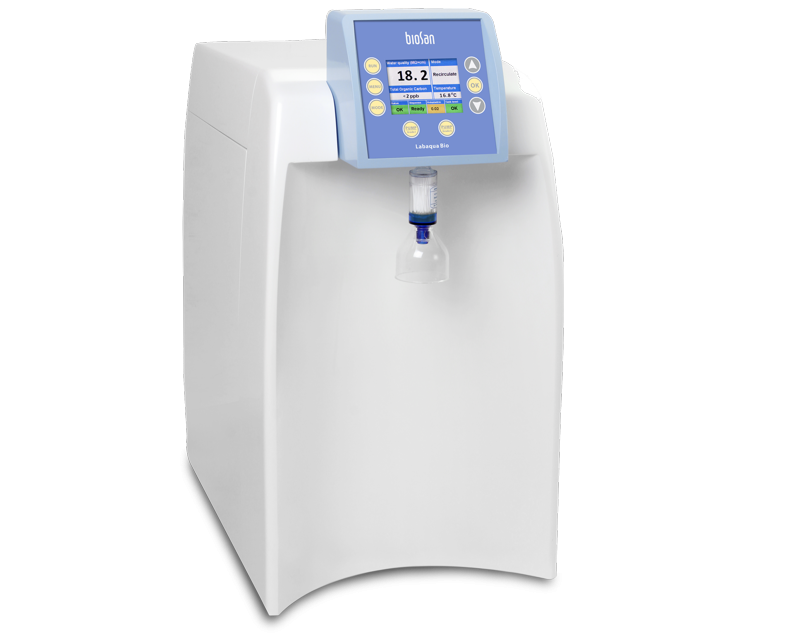


Labaqua ultrapure systems are multi-purpose water purification systems. The Labaqua systems produce ultrapure and pure water directly from tap water.
Labaqua Bio system produces water with very low organic and RNase/DNase content that is intended for the use in molecular biology, including RNase sensitive applications.
Any configuration of a Labaqua ultrapure system produces both ultrapure and pure water. Ultrapure (Grade 1) water is dispensed through the point-of-use filter on the front panel. Pure (Grade 2) water is dispensed directly from the storage tank.
Labaqua ultrapure water can be used for the most demanding applications including, but not limited to: Inorganic trace analysis, Liquid chromatography, Cell culture, Molecular biology.
With resistivity of 18.2 Mega — Ohm*cm (0.055 μS/cm) ultrapure water produced by a Labaqua system exceeds requirements of all relevant standards (ISO 3696 Grade 1, ASTM Type I, CLSI Type I). Purified water is collected in a storage tank. An integrated recirculation system ensures consistent quality of water and reduces total organic carbon (TOC) to very low levels: <2ppb.
Pure water produced by the Labaqua systems complies with the requirements of ISO 3696 Grade 2 water and can be used for labware washing, wet chemistry methods, flame spectrophotometers, etc.
All Labaqua systems have a controller with a color graphic LCD display for water quality indication. The LCD display provides all necessary information about system status, as well as system flow-chart the remaining pre-filter life and deionization (DI) module performance. The smart DI module monitoring system also provides a reduction in running costs. A user is instructed to replace the DI module only when the module is near the end of its service life.
All cartridges and filters are easily accessible and no tools are required to replace them. The Labaqua system can be installed on a laboratory bench or mounted on a wall.
Features:
The Labaqua systems include:
Model specific modules:
Compliance of the system with the technical specification is ensured if the following minimum tap water requirements are followed and the maintenance requirements specified in the user manual are carried out in a timely manner.
| Ultrapure (Grade 1) water resistivity | 18.2 MΩ x cm |
|---|---|
| Ultrapure (Grade 1) water conductivity | 0.055 μS/cm |
| Pure (Grade 2) water resistivity | > 10 MΩ x cm |
| Pure (Grade 2) water conductivity | < 0.1 μS/cm |
| TOC | < 2 ppb |
| RNase | < 0.01 ng/ml |
| DNase | < 4 pg/μl |
| Bacteria | < 0.01 CFU/ml |
| Endotoxins | < 0.001 EU/ml |
| Particles > 0.22 μm | < 1/ml |
| Deionization module life (standard module) | 1 m3 |
| Storage tank | 30 l |
| Feed water pressure | 0.5 – 5 bar |
| Feed water conductivity | < 1300 μS/cm |
| Dimensions (W×D×H) | 320×560×620 mm |
| Weight | 26 kg |
| Power consumption | 130 W |
| Nominal operating voltage | 230 V, 50/60 Hz |